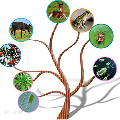Due to the intrinsically inefficient service provisioning in traditional networks, Network Function Virtualization (NFV) keeps gaining attention from both industry and academia. By replacing the purpose-built, expensive, proprietary network equipment with software network functions consolidated on commodity hardware, NFV envisions a shift towards a more agile and open service provisioning paradigm with much lower capital expenditure (CapEx) and operational expenditure (OpEx). Nonetheless, just like any complex system, NFV platforms commonly consist of abounding software and hardware components and usually incorporate disparate design choices based on distinct motivations or use cases. This broad collection of convoluted alternatives makes it extremely arduous for network operators to make proper choices. Although numerous efforts have been devoted to investigating different aspects of NFV, none of them specifically focused on NFV platforms or attempted to explore the design space. In this paper, we present a comprehensive survey on NFV platform design. Our study solely targets existing NFV platform implementations. We begin with an architectural view of the standard reference NFV platform and present our taxonomy of existing NFV platforms based on the principal purpose of design. Then we thoroughly explore the design space and elaborate on the implementation choices each platform opts for. We believe that our study gives a detailed guideline for network operators or service providers to choose or implement the most appropriate NFV platforms based on their respective requirements. Note that this report serves as a complementary document for a published IEEE TNSM paper [1]. We will periodically update this document to include the newly proposed NFV platforms and design choices.
翻译:由于传统网络提供的服务本质上效率低下,网络功能虚拟化(NFV)一直受到产业界和学术界的注意。通过用综合商品硬件软件网络功能取代目的设计、昂贵、专有的网络设备,NFV设想转向更加灵活和开放的服务提供模式,降低资本支出(CapEx)和业务支出(OpEx),然而,与任何复杂的系统一样,NFV平台通常由大量软件和硬件组成,通常包括基于不同动机或使用的平台的不同设计选择。这种广泛收集的复杂替代品使得网络操作者很难做出正确的选择。虽然已经作出许多努力,调查NFV的不同方面,但没有一个专门侧重于NFV平台或试图探索设计空间。我们在本文件中介绍了关于NFV平台设计的全面调查。我们的研究仅仅针对现有的NFV平台的实施。我们首先从一个基于不同动机或使用的平台的标准参考框架的建筑观点开始,并介绍了我们基于设计主要目的的现有NFV平台的分类,使得网络操作者很难做出正确的选择。我们随后彻底地探索了每个空间设计平台,或者详细研究,以便执行我们的网络设计平台。我们用一份基于最新文件的文件。我们选择空间设计或详细的指南。





